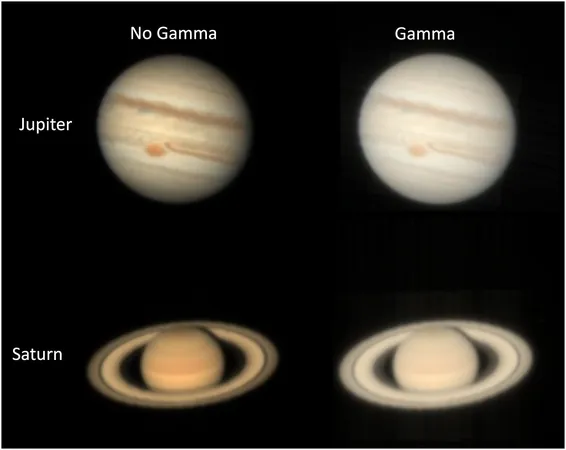
Breaking News: Shocking New Findings About Jupiter’s Clouds - They're NOT What We Thought!
2025-01-06
Author: Jacob
Revolutionary Discovery about Jupiter's Clouds
In an exciting breakthrough for astronomy, a collaboration of amateur and professional astronomers has overturned the long-held belief that Jupiter’s mesmerizing clouds are predominantly made of ammonia ice. Instead, researchers are now suggesting that these iconic clouds consist mainly of ammonium hydrosulfide mixed with atmospheric smog.
The Amateur Astronomer's Journey
This groundbreaking revelation has been detailed in the Journal of Geophysical Research: Planets, and it all started with a passionate amateur astronomer, Dr. Steven Hill from Colorado. Using commercially available telescopes and a few specially colored filters, Dr. Hill was able to map the distribution of ammonia and cloud-top pressure in Jupiter’s thick atmosphere.
The Depths of Jupiter's Atmosphere
What’s truly astonishing is that these findings reveal that the clouds on Jupiter reside much deeper within its warm atmosphere than previously thought, making the formation of ammonia ice highly unlikely. Instead, they likely consist of ammonium hydrosulfide due to the extreme conditions present.
Advanced Confirmation by Experts
Professor Patrick Irwin from the University of Oxford took Dr. Hill's innovative analytical method further, utilizing the cutting-edge Multi Unit Spectroscopic Explorer (MUSE) at the European Southern Observatory’s Very Large Telescope in Chile. By studying the spectral fingerprints of Jupiter’s gases at varying wavelengths, Irwin and his team confirmed that the clouds we observe through amateur telescopes actually sit in a region of higher pressure and temperature—too hot for ammonia condensation.
Simplification of Complex Studies
While prior studies using MUSE had hinted at such findings, their complexity made them hard to verify. However, this new, simplified method, pioneered by Dr. Hill's work, offers a faster and more accessible way to gather similar results. Professor Irwin expressed amazement at this revelation, stating, "It’s incredible that a technique as straightforward as this can provide deep insights into Jupiter’s atmosphere!"
Empowering Citizen Scientists
Dr. Hill, who holds a Ph.D. in Astrophysics and specializes in space weather forecasting, noted his determination to push the limits of what can be achieved with affordable equipment, never anticipating such significant outcomes.
The Role of Photochemistry
Moreover, the ammonia mapping technique developed from this research stands to benefit citizen scientists, allowing them to monitor variations in ammonia and cloud-top pressure across Jupiter’s surface. From its distinct bands to small cyclones and the majestic Great Red Spot, enthusiasts can contribute meaningfully to our understanding of the gas giant’s dynamic atmosphere.
Why Ammonia Doesn't Condense
But why doesn’t ammonia condense to form those thick clouds we’ve been picturing for so long? The answer lies in photochemistry—sunlight-driven chemical reactions are prevalent in Jupiter’s atmosphere. In areas where moist, ammonia-rich air rises, ammonia compounds may break down or undergo swift mixing with photochemical products, inhibiting the formation of ammonia ice.
Research Extended to Saturn
Professor Irwin and his team also extended their analysis to Saturn, utilizing the same methodology, with consistent outcomes corroborated by observations from the James Webb Space Telescope.
The Future of Astronomy
As new amateur astronomers step up and collaborate with seasoned professionals, who knows what other celestial secrets await discovery? Stay tuned as we delve deeper into the mysteries of our Solar System!



 Brasil (PT)
Brasil (PT)
 Canada (EN)
Canada (EN)
 Chile (ES)
Chile (ES)
 Česko (CS)
Česko (CS)
 대한민국 (KO)
대한민국 (KO)
 España (ES)
España (ES)
 France (FR)
France (FR)
 Hong Kong (EN)
Hong Kong (EN)
 Italia (IT)
Italia (IT)
 日本 (JA)
日本 (JA)
 Magyarország (HU)
Magyarország (HU)
 Norge (NO)
Norge (NO)
 Polska (PL)
Polska (PL)
 Schweiz (DE)
Schweiz (DE)
 Singapore (EN)
Singapore (EN)
 Sverige (SV)
Sverige (SV)
 Suomi (FI)
Suomi (FI)
 Türkiye (TR)
Türkiye (TR)
 الإمارات العربية المتحدة (AR)
الإمارات العربية المتحدة (AR)